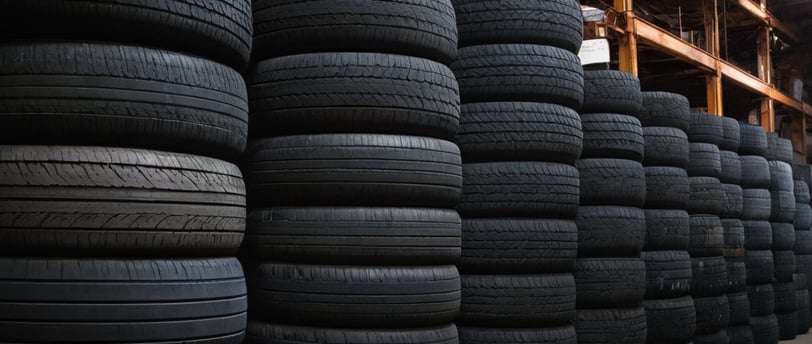5 Signs You Need New Tyres – Expert Advice from Fred’s Mobile Tyres
5/22/20257 min read


Introduction
Maintaining your vehicle's tyres is fundamental not only for performance but also for ensuring optimal safety on the road. Tyres are the only point of contact between your vehicle and the surface beneath, significantly influencing handling, braking, and overall driving comfort. Regular tyre maintenance plays a critical role in enhancing vehicle efficiency, as well as in prolonging the lifespan of the tyres. Thus, checking for wear and tear should not be considered an afterthought but rather an essential aspect of routine vehicle care.
Expertise in tyre maintenance is invaluable; Fred’s Mobile Tyres specializes in diagnosing tyre issues and providing prompt solutions tailored to each vehicle's needs. Whether it is identifying subtle signs of wear or addressing more pressing concerns, the team at Fred’s Mobile Tyres is equipped with the knowledge and tools necessary for effective tyre service. Their commitment to ensuring road safety extends beyond mere fittings; it encompasses a thorough understanding of how each component of a tyre contributes to the vehicle’s overall performance.
Understanding the nuances of tyre maintenance empowers vehicle owners to make informed decisions. Factors such as tread depth, air pressure, and visible damage should be regularly assessed to determine if new tyres are necessary. Early detection of issues can prevent them from escalating, resulting in safer travel and potentially avoiding costly repairs. By prioritizing tyre checks, drivers can not only enhance their vehicle’s performance but also protect themselves and others on the road. In the following sections, we will explore several critical signs that indicate you may need new tyres, ensuring you are well-informed in your vehicle maintenance journey.
Sign 1: Tread Wear Indicators
The tread depth of your tyres is a crucial aspect of maintaining vehicle safety and performance. Proper tread depth ensures effective traction and grip on the road, particularly in adverse weather conditions such as rain or snow. One of the most straightforward methods to assess the health of your tyres is by using tread wear indicators, which are small bars embedded within the tread grooves of the tyre. As tyres wear down, these bars become more visible, marking the threshold at which the tyre should be replaced.
The legal minimum tread depth in many regions, including the UK, is 1.6mm across the central three-quarters of the tyre. However, for optimal safety, particularly during wet conditions, it is advisable to replace your tyres well before reaching that limit. Tread depths of 3mm or more are generally recommended for better performance in rain, as they ensure adequate water dispersal and enhance grip.
To measure the tread depth, you can use a ruler or a depth gauge, though many drivers find it accessible to use a 20 pence coin as a quick check. Insert the coin into the tread; if the outer band of the coin is visible, then it indicates that the tread depth is below optimal levels, suggesting a need for replacement. Regular inspections of your tyres, coupled with awareness of the tread wear indicators, are your best defense against poor road traction.
In summary, monitoring tread wear indicators is essential for ensuring your tyres provide the necessary grip for safe driving. Neglecting this crucial maintenance can lead to diminished performance, increased stopping distances, and an elevated risk of accidents, particularly in compromising weather conditions.
Sign 2: Cracks and Bulges
One of the most visible indicators that tyres may require replacement is the emergence of cracks and bulges on the sidewalls. These signs are critical to monitor, as they can directly affect vehicle safety and performance. Cracks typically appear as small fissures that may develop due to a variety of reasons, including age, exposure to extreme temperatures, and general wear and tear. In contrast, bulges represent a more severe concern; they occur when there is a separation between the outer rubber and the underlying layers, often due to a manufacturing defect, impact damage, or prolonged wear.
The presence of cracks can weaken the structural integrity of the tyre, increasing the risk of a blowout during operation. In addition, the formation of bulges can indicate that air pressure has compromised the tyre's overall composition, making it unsafe for daily driving. It is essential for vehicle owners to conduct regular inspections, looking closely at the sides of their tyres for any visible signs of damage. Factors such as the tyre's age, driving conditions, and maintenance routines should also inform assessments of their condition.
If any cracks or bulges are detected, it is advisable to consult a professional service, such as Fred’s Mobile Tyres, for expert advice. Experienced technicians can accurately evaluate the severity of the damage and recommend appropriate actions, whether it be repairs or complete tyre replacement. Neglecting these signs can lead not only to compromised safety on the road but also to more significant, expensive issues in the long run. Therefore, prioritizing tyre safety by monitoring for cracks and bulges should be a paramount aspect of vehicle maintenance.
Sign 3: Uneven Wear Patterns
Uneven wear patterns on tyres are a significant indicator that your vehicle may require new tyres or that there are underlying issues affecting their performance. Identifying these patterns is crucial for ensuring your safety and maintaining the longevity of your tyres. Common signs of uneven wear can include excessive wear on one side of the tyre, patchy areas of loss of tread, or bald spots that appear prematurely. Such inconsistencies often point to alignment issues or improper inflation that need to be addressed promptly.
Wheel alignment plays a vital role in ensuring that your tyres wear evenly. If your vehicle's suspension system is not properly aligned, it can lead to excessive wear on the inner or outer edges of your tyres. Drivers may notice that their steering feels off-center or that they must steer slightly to keep the vehicle straight, which can exacerbate wear. Regular wheel balancing is equally important; unbalanced tyres can cause vibrations and lead to inconsistent wear across the tyre's surface.
Improper tyre pressure is another contributing factor to uneven tyre wear. Over-inflation can cause the centre of the tyre to wear more quickly, while under-inflation can lead to excessive wear on the outer edges. It is essential to regularly check tyre pressure using a quality gauge, following the manufacturer's recommended levels for optimal performance.
To maintain even tyre wear and prolong the life of your tyres, consider incorporating regular maintenance practices such as tyre rotation, alignment checks, and balancing services into your vehicle upkeep regimen. Looking for signs of wear as described above ensures that your driving experience remains safe and comfortable, and addressing these issues promptly can save you from the costs associated with premature tyre replacement.
Sign 4: Vibration and Noise
When driving, vibrations or unusual noises emanating from your vehicle can serve as crucial indicators of underlying tyre problems. If you experience shaking in the steering wheel or a noticeable rumble, it may be time to examine your tyres more closely. These symptoms can arise for several reasons, including uneven tyre wear, misalignment, or even issues with the vehicle's suspension system.
Vibrations typically indicate that your tyres may be unbalanced. If they are not properly balanced, the weight distribution across the tyre can lead to significant vibrations, affecting the comfort and stability of your ride. Furthermore, steered vibrations can denote an imbalance that not only hampers your driving experience but also increases wear on suspension components. Regularly checking the balance of your tyres can combat this issue, ensuring a smoother and safer journey.
Unusual noises can arise from a variety of tyre issues, including low tread depth or even internal damage within the tyre. A humming or roaring sound can be indicative of worn-out tyres, while a thumping noise might suggest a bulge or other structural defects. Addressing these noises promptly is essential, as their presence may point towards an impending tyre failure that could compromise your safety on the road.
Should you encounter vibrations or strange noises while driving, it is advisable to visit a professional such as Fred’s Mobile Tyres. Experts can assess the condition of your tyres and recommend necessary actions, including rotation, alignment, or replacement. By prioritizing these signs, you can maintain optimal tyre performance, thereby enhancing your overall driving safety and comfort.
Sign 5: Age of the Tyres
The age of tyres is a critical factor that drivers often overlook while assessing their vehicle’s safety and performance. Regardless of tread wear, rubber compounds degrade over time, leading to reduced traction and increased risk of blowouts. To ensure safety on the road, it is vital to monitor the age of your tyres closely.
To determine the age of your tyres, you can check the Department of Transportation (DOT) code stamped on the sidewall. The last four digits of this code indicate the week and year of manufacturing. For example, if the DOT code ends in '2219', it indicates that the tyre was produced in the 22nd week of 2019. As a general rule, tyres should be replaced every six years, even if they show minimal wear and tear. Some tyre manufacturers and experts suggest considering replacement after five years, as the rubber’s elasticity and performance qualities begin to diminish over time.
It is essential to note that certain driving conditions can accelerate the ageing process, such as exposure to extreme temperatures and sunlight, as well as regular high-speed driving. Thus, vehicles that are not used frequently should also have their tyres inspected regularly to assess their age and condition. Even if the tyres appear physically intact, the risk of internal damage increases as the tyres age, which may not be visible during a visual inspection.
In conclusion, age is a significant indicator of tyre safety. Adhering to replacement recommendations based on the age of your tyres will contribute to your overall driving security and performance. Ensuring tyres are within their safe life span is an essential aspect of responsible vehicle maintenance. Make a habit of checking the DOT code to resolve potential hazards before they pose a threat on the road.
Conclusion and Recommendations
In conclusion, maintaining the safety and performance of your vehicle heavily relies on recognizing the signs of tyre wear and tear. Throughout this discussion, we highlighted five critical indicators that suggest you may need new tyres: reduced tread depth, visible damage, uneven wear patterns, loss of traction, and vibrations during driving. Each of these signs can signify potential safety hazards and should prompt immediate attention.
Regular tyre maintenance is essential not just for extending tyre lifespan, but also for ensuring optimal driving safety. Inspections and adjustments for alignment and balance, routine checks for air pressure, and being attentive to any changes in your vehicle's handling can prevent costly repairs and unsafe driving conditions down the line. Keeping your tyres in good condition supports better fuel efficiency, enhances vehicle performance, and promotes overall road safety for you and those around you.
Should you identify any of the aforementioned signs, or if you have not had your tyres inspected recently, we highly recommend that you take the necessary steps to address these concerns as soon as possible. Fred’s Mobile Tyres offers professional tyre inspection and replacement services to assist you in maintaining the quality of your vehicle's tyres. Our qualified technicians are equipped to provide tailored solutions to meet your needs. For more information or to schedule your tyre inspection, please visit our website or contact us directly. Your safety on the road is our top priority, and we are here to help ensure that your drive remains smooth and secure.
Services
24/7 mobile tyre fitting service in the Midlands.
Quality
Support
07310146835
© 2025. All rights reserved.


